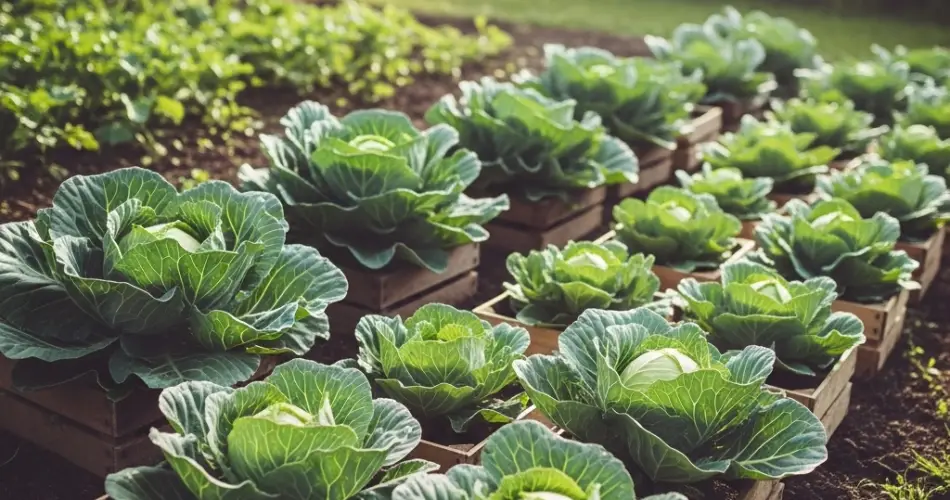Cabbage is a nutritious, versatile vegetable that can thrive even in small garden spaces when grown in crates. DIY crate gardening offers an efficient and manageable way to cultivate cabbage on balconies, patios, or limited outdoor areas. With the right preparation and care, you can enjoy fresh, homegrown cabbage without needing a traditional garden plot.
Why Grow Cabbage in Crates?
Wooden crates provide an excellent container option for cabbage due to their depth, breathability, and rustic charm. They allow good drainage and air circulation, which are essential for healthy root development and preventing diseases.
Crate gardening also enables gardeners to control soil quality, watering, and sunlight exposure more precisely. This method is particularly ideal for urban gardeners or those with limited ground space.
Materials Needed
To start growing cabbage in crates, gather the following:
-
Wooden crates at least 12 inches deep and wide enough to accommodate cabbage heads (approximately 18 inches)
-
Landscape fabric or burlap for lining
-
Quality potting soil enriched with compost or organic matter
-
Cabbage seedlings or seeds
-
Organic fertilizer or compost tea
-
Watering can or hose with a gentle spray setting
Preparing the Crate
Line the crate with landscape fabric or burlap to prevent soil loss while ensuring adequate drainage. If the crate doesn’t have holes, drill several drainage holes in the bottom to prevent waterlogging.
Fill the crate with a rich, well-draining potting mix. Cabbage prefers fertile, moist soil with good organic content. Avoid using heavy garden soil alone, as it can become compacted and inhibit root growth.
Choosing the Right Cabbage Variety
Compact or early-maturing cabbage varieties work best for container gardening. Some recommended types include:
-
Early Ball: A small, round cabbage suitable for quick harvests.
-
Golden Acre: Known for its tight heads and compact growth.
-
Savoy Cabbage: Offers crinkled leaves and a milder flavor, with smaller heads.
Selecting the right variety helps ensure the plants fit comfortably within the crate and mature within your growing season.
Planting Your Cabbage
If starting with seeds, sow them indoors or in a seed tray 6 to 8 weeks before transplanting. When seedlings have developed 3 to 4 true leaves and the outdoor temperature is suitable (above 50°F or 10°C), transplant them into the crate.
Space seedlings about 12 to 18 inches apart to allow room for mature heads to form. Dig holes slightly larger than the root balls, plant the seedlings at the same depth they grew previously, and firm the soil gently around the base.
Water immediately after planting.
Placement and Sunlight
Cabbage needs at least 6 hours of sunlight daily to grow well. Place your crate in a sunny spot on your balcony or patio, preferably with morning sun and some afternoon shade if you live in a hot climate.
Rotate the crate periodically to ensure even light exposure and prevent plants from leaning toward the sun.
Watering and Feeding
Keep the soil consistently moist but not waterlogged. Cabbage has shallow roots that need regular watering, especially during dry spells. Mulching around the plants can help retain moisture and keep the soil cool.
Feed your plants with an organic fertilizer or compost tea every two to three weeks. Cabbage benefits from nitrogen-rich fertilizers during the early growth stage, then a balanced fertilizer as heads develop.
Pest and Disease Management
Cabbage can attract pests such as aphids, cabbage worms, and flea beetles. Inspect your plants regularly and manage pests early. Handpick worms or use organic controls like neem oil or insecticidal soap.
Good airflow and avoiding overhead watering reduce the risk of fungal diseases like powdery mildew or black rot.
Harvesting Your Cabbage
Cabbage heads are ready to harvest when they feel firm and dense to the touch. Depending on the variety, this can take anywhere from 60 to 90 days after transplanting.
Use a sharp knife to cut the head at the base, leaving the outer leaves and roots in the crate. This can sometimes encourage a smaller second growth.
End-of-Season Care
Once harvested, remove old leaves and plant debris to keep the crate clean. Refresh the soil with compost and prepare for your next crop. Rotating crops helps maintain soil health and reduce pests.
Conclusion
DIY crate gardening is a smart, space-saving way to grow fresh cabbage even in the tightest spaces. With proper soil, watering, and care, you can enjoy crisp, flavorful cabbage from your balcony or patio. This method not only maximizes limited space but also brings the satisfaction of homegrown produce right to your doorstep.



